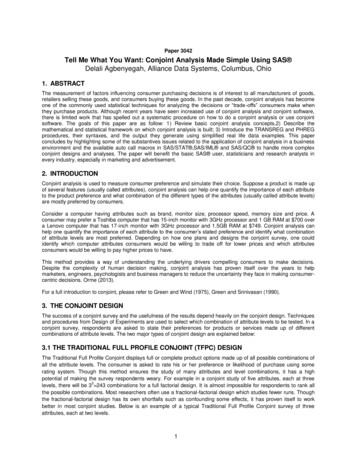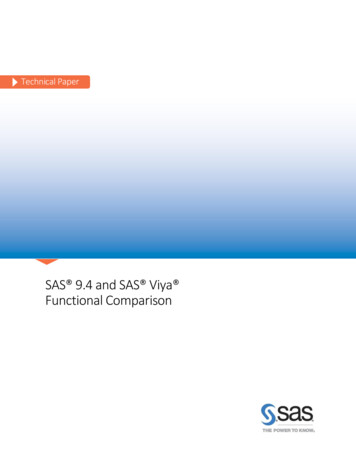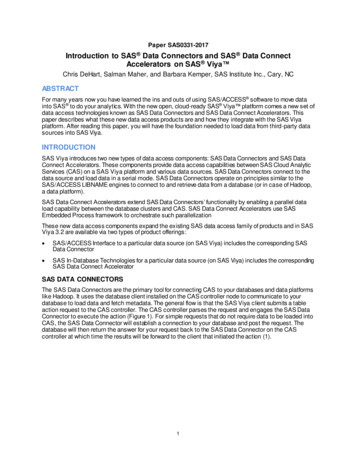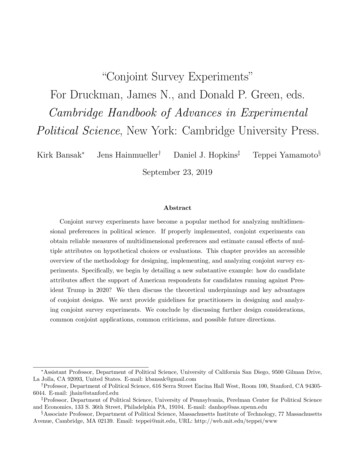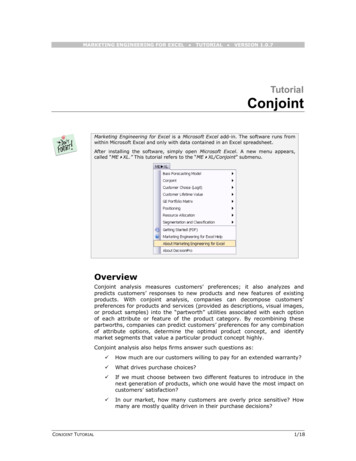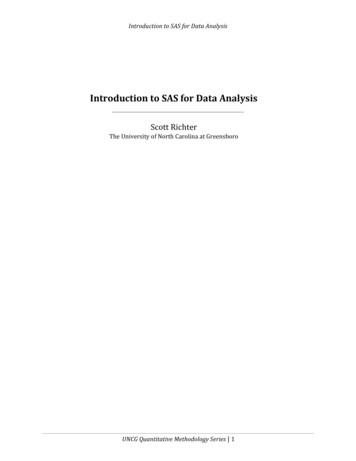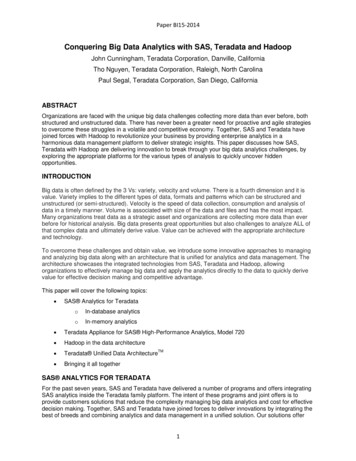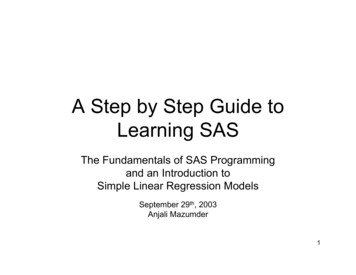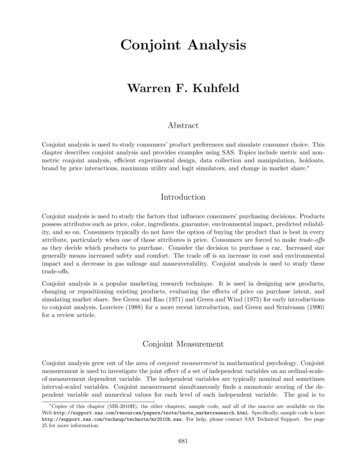
Transcription
Conjoint AnalysisWarren F. KuhfeldAbstractConjoint analysis is used to study consumers’ product preferences and simulate consumer choice. Thischapter describes conjoint analysis and provides examples using SAS. Topics include metric and nonmetric conjoint analysis, efficient experimental design, data collection and manipulation, holdouts,brand by price interactions, maximum utility and logit simulators, and change in market share. IntroductionConjoint analysis is used to study the factors that influence consumers’ purchasing decisions. Productspossess attributes such as price, color, ingredients, guarantee, environmental impact, predicted reliability, and so on. Consumers typically do not have the option of buying the product that is best in everyattribute, particularly when one of those attributes is price. Consumers are forced to make trade-offsas they decide which products to purchase. Consider the decision to purchase a car. Increased sizegenerally means increased safety and comfort. The trade off is an increase in cost and environmentalimpact and a decrease in gas mileage and maneuverability. Conjoint analysis is used to study thesetrade-offs.Conjoint analysis is a popular marketing research technique. It is used in designing new products,changing or repositioning existing products, evaluating the effects of price on purchase intent, andsimulating market share. See Green and Rao (1971) and Green and Wind (1975) for early introductionsto conjoint analysis, Louviere (1988) for a more recent introduction, and Green and Srinivasan (1990)for a review article.Conjoint MeasurementConjoint analysis grew out of the area of conjoint measurement in mathematical psychology. Conjointmeasurement is used to investigate the joint effect of a set of independent variables on an ordinal-scaleof-measurement dependent variable. The independent variables are typically nominal and sometimesinterval-scaled variables. Conjoint measurement simultaneously finds a monotonic scoring of the dependent variable and numerical values for each level of each independent variable. The goal is to Copies of this chapter (MR-2010H), the other chapters, sample code, and all of the macros are available on theWeb e marketresearch.html. Specifically, sample code is h.sas. For help, please contact SAS Technical Support. See page25 for more information.681
682MR-2010H — Conjoint Analysismonotonically transform the ordinal values to equal the sum of their attribute level values. Hence,conjoint measurement is used to derive an interval variable from ordinal data. The conjoint measurement model is a mathematical model, not a statistical model, since it has no statistical error term.Conjoint AnalysisConjoint analysis is based on a main effects analysis-of-variance model. Subjects provide data abouttheir preferences for hypothetical products defined by attribute combinations. Conjoint analysis decomposes the judgment data into components, based on qualitative attributes of the products. A numericalpart-worth utility value is computed for each level of each attribute. Large part-worth utilities are assigned to the most preferred levels, and small part-worth utilities are assigned to the least preferredlevels. The attributes with the largest part-worth utility range are considered the most important inpredicting preference. Conjoint analysis is a statistical model with an error term and a loss function.Metric conjoint analysis models the judgments directly. When all of the attributes are nominal, themetric conjoint analysis is a simple main-effects ANOVA with some specialized output. The attributesare the independent variables, the judgments comprise the dependent variable, and the part-worthutilities are the β’s, the parameter estimates from the ANOVA model. The following formula shows ametric conjoint analysis model for three factors:yijk µ β1i β2j β3k ijkwhereXβ1i Xβ2j Xβ3k 0This model could be used, for example, to investigate preferences for cars that differ on three attributes:mileage, expected reliability, and price. The yijk term is one subject’s stated preference for a car withthe ith level of mileage, the jth level of expected reliability, and the kth level of price. The grand meanis µ, and the error is ijk . The predicted utility for the ijk product is:ŷijk µ̂ β̂1i β̂2j β̂3kNonmetric conjoint analysis finds a monotonic transformation of the preference judgments. The model,which follows directly from conjoint measurement, iteratively fits the ANOVA model until the transformation stabilizes. The R square increases during every iteration until convergence, when the changein R square is essentially zero. The following formula shows a nonmetric conjoint analysis model forthree factors:Φ(yijk ) µ β1i β2j β3k ijkwhere Φ(yijk ) designates a monotonic transformation of the variable y.The R square for a nonmetric conjoint analysis model is always greater than or equal to the R squarefrom a metric analysis of the same data. The smaller R square in metric conjoint analysis is not
MR-2010H — Conjoint Analysis683necessarily a disadvantage, since results should be more stable and reproducible with the metric model.Metric conjoint analysis was derived from nonmetric conjoint analysis as a special case. Today, metricconjoint analysis is probably used more often than nonmetric conjoint analysis.In the SAS System, conjoint analysis is performed with the SAS/STAT procedure TRANSREG (transformation regression). Metric conjoint analysis models are fit using ordinary least squares, and nonmetric conjoint analysis models are fit using an alternating least squares algorithm (Young 1981; Gifi1990). Conjoint analysis is explained more fully in the examples. The “PROC TRANSREG Specifications” section of this chapter starting on page 789 documents the PROC TRANSREG statementsand options that are most relevant to conjoint analysis. The “Samples of PROC TRANSREG Usage”section starting on page 799 shows some typical conjoint analysis specifications. This chapter showssome of the SAS programming that is used for conjoint analysis. Alternatively, there is a marketingresearch GUI that performs conjoint analysis available from the main display manager PMENU byselecting: Solutions Analysis Market Research.Choice-Based ConjointThe meaning of the word “conjoint” has broadened over the years from conjoint measurement toconjoint analysis (which at first always meant what we now call nonmetric conjoint analysis) and laterto metric conjoint analysis. Metric and nonmetric conjoint analysis are based on a linear ANOVAmodel. In contrast, a different technique, discrete choice, is based on the nonlinear multinomial logitmodel. Discrete choice is sometimes referred to as “choice-based conjoint.” This technique is notdiscussed in this chapter, however it is discussed in detail starting on page 285.Experimental DesignExperimental design is a fundamental component of conjoint analysis. A conjoint study uses experimental design to create a list of products that vary on an assortment of attributes such as brand, price,size, and so on, and subjects rate or rank the products. There are many examples of making conjointdesigns in this chapter. Before you read them, be sure to read the design chapters beginning on pages53 and 243.The Output Delivery SystemThe Output Delivery System (ODS) can be used to customize the output of SAS procedures includingPROC TRANSREG, the procedure we use for conjoint analysis. PROC TRANSREG can produce agreat deal of information for conjoint analysis, more than we often wish to see. We use ODS primarilyto exclude certain portions of the default conjoint output in which we are usually not interested. Thiscreates a better, more parsimonious display for typical analyses. However, when we need it, we canrevert back to getting the full array of information. See page 287 for other examples of customizingoutput using ODS. You can run the following step once to customize PROC TRANSREG conjointanalysis output:
684MR-2010H — Conjoint Analysisproc template;edit Stat.Transreg.ParentUtilities;column Label Utility StdErr tValue Probt Importance Variable;header title;define title; text ’Part-Worth Utilities’; space 1; end;define Variable; print off; end;end;run;Running this step edits the templates for the main conjoint analysis results table and stores a copy insasuser. These changes remain in effect until you delete them. These changes move the variable labelto the first column, turn off displaying the variable names, and set the table header to “Part-WorthUtilities”. These changes assume that each effect in the model has a variable label associated with it,so there is no need to display variable names. This is usually be the case. To return to the defaultoutput, run the following step:* Delete edited template, restore original template;proc template;delete Stat.Transreg.ParentUtilities;run;By default, PROC TRANSREG displays an ANOVA table for metric conjoint analysis and bothunivariate and multivariate ANOVA tables for nonmetric conjoint analysis. With nonmetric conjointanalysis, PROC TRANSREG sometimes displays liberal and conservative ANOVA tables. All of thepossible ANOVA tables, along with some header notes, can be suppressed by specifying the followingstatement before running PROC TRANSREG:ods exclude notes anova liberalanova conservanovamvanova liberalmvanova conservmvanova;For metric conjoint analysis, this statement can be abbreviated as follows:ods exclude notes mvanova anova;The rest of this section gives more details about what the PROC TEMPLATE step does and why. Therest of this section can be helpful if you wish to further customize the output from TRANSREG orsome other procedure. Impatient readers may skip ahead to the candy example on page 687.We are most interested in the part-worth utilities table in conjoint analysis, which contains the partworth utilities, their standard errors, and the importance of each attribute. We can first use PROCTEMPLATE to identify the template for the utilities table and then edit the template. First, let’shave PROC TEMPLATE display the templates for PROC TRANSREG. The source stat.transregstatement in the following step specifies that we want to see PROC TEMPLATE source code for theSTAT product and the TRANSREG procedure:proc template;source stat.transreg;run;If we search the results for “Utilities”, we find the template for the part-worth utilities table is calledStat.Transreg.ParentUtilities. The template is as follows:
MR-2010H — Conjoint Analysisdefine table Stat.Transreg.ParentUtilities;notes "Parent Utilities Table for Proc Transreg";dynamic FootMessages TitleText;column Label Utility StdErr tValue Probt Importance Variable;header Title;footer Foot;define Title;text TitleText;space 1;spill margin;first panel;end;define Label;parent Stat.Transreg.Label;style RowHeader;end;define Utility;header "Utility";format width 7;parent Stat.Transreg.Coefficient;end;define StdErr;parent Stat.Transreg.StdErr;end;define tValue;parent Stat.Transreg.tValue;print OFF;end;define Probt;parent Stat.Transreg.Probt;print OFF;end;define Importance;header %nrstr(";Importance;%(%% Utility;Range%)");translate val . into " ";format 7.3;end;define Variable;parent Stat.Transreg.Variable;end;define Foot;text FootMessages;just l;maximize;end;685
686MR-2010H — Conjoint Analysiscontrol control;required space 20;end;Recall that we ran the following step to customize the output:proc template;edit Stat.Transreg.ParentUtilities;column Label Utility StdErr tValue Probt Importance Variable;header title;define title; text ’Part-Worth Utilities’; space 1; end;define Variable; print off; end;end;run;We specify the edit Stat.Transreg.ParentUtilities statement to name the table that we wish tochange. The column statement is copied from the PROC TEMPLATE source listing, and it namesall of the columns in the table. Some, like tValue and Probt do not display by default. We cansuppress the Variable column by using the print off option. We redefine the table header to read“Part-Worth Utilities”. The names in the column and header statements must match the names inthe original template.
MR-2010H — Chocolate Candy Example687Chocolate Candy ExampleThis example illustrates conjoint analysis with rating scale data and a single subject. The subject wasasked to rate his preference for eight chocolate candies. The covering was either dark or milk chocolate,the center was either chewy or soft, and the candy did or did not contain nuts. The candies were ratedon a 1 to 9 scale where 1 means low preference and 9 means high preference. Conjoint analysis isused to determine the importance of each attribute and the part-worth utility for each level of eachattribute.Metric Conjoint AnalysisAfter data collection, the attributes and the rating data are entered into a SAS data set, for example,as follows:title ’Preference for Chocolate Candies’;data choc;input Chocolate Center Nuts & Rating;datalines;Dark Chewy Nuts7Dark Chewy No Nuts6Dark SoftNuts6Dark SoftNo Nuts4Milk Chewy Nuts9Milk Chewy No Nuts8Milk SoftNuts9Milk SoftNo Nuts7;Note that the “&” specification in the input statement is used to read character data with embeddedblanks.PROC TRANSREG is used to perform a metric conjoint analysis, for example, as follows:ods exclude notes mvanova anova;proc transreg utilities separators ’, ’ short;title2 ’Metric Conjoint Analysis’;model identity(rating) class(chocolate center nuts / zero sum);run;The displayed output from the metric conjoint analysis is requested by specifying the utilities optionin the proc statement. The value specified in the separators option, in this case a comma followedby a blank, is used in constructing the labels for the part-worth utilities in the displayed output. Withthese options, the labels consist of the class variable name, a comma, a blank and the values of theclass variables. We specify the short option to suppress the iteration history. PROC TRANSREG stilldisplays a convergence summary table so we will know if there are any convergence problems. Since thisis a metric conjoint analysis, there should be only one iteration and there should not be any problems.We specify ods exclude notes mvanova anova to exclude ANOVA information (which we usually
688MR-2010H — Conjoint Analysiswant to ignore) and provide more parsimonious output. The analysis variables, the transformation ofeach variable, and transformation specific options are specified in the model statement.The model statement provides for general transformation regression models, so it has a markedlydifferent syntax from other SAS/STAT procedure model statements. Variable lists are specified inparentheses after a transformation name. The specification identity(rating) requests an identitytransformation of the dependent variable Rating. A transformation name must be specified for allvariable lists, even for the dependent variable in metric conjoint analysis, when no transformationis desired. The identity transformation of Rating does not change the original scoring. An equalsign follows the dependent variable specification, then the attribute variables are specified along withtheir transformation. The following specification designates the attributes as class variables with therestriction that the part-worth utilities sum to zero within each attribute:class(chocolate center nuts / zero sum)A slash must be specified to separate the variables from the transformation option zero sum. Theclass specification creates a main-effects design matrix from the specified variables. This exampledoes not produce any data sets; later examples show how to store results in output SAS data sets.The results are as follows:Preference for Chocolate CandiesMetric Conjoint AnalysisThe TRANSREG ProcedureDependent Variable Identity(Rating)Class Level er2ChewyNuts2No NutsSoftNutsNumber of Observations ReadNumber of Observations Used88The TRANSREG Procedure Hypothesis Tests for Identity(Rating)Root MSEDependent MeanCoeff Var0.500007.000007.14286R-SquareAdj R-Sq0.95000.9125
MR-2010H — Chocolate Candy Example689Part-Worth UtilitiesImportance(% olate, DarkChocolate, Milk-1.25001.25000.176780.1767850.000Center, ChewyCenter, Soft0.5000-0.50000.176780.1767820.000Nuts, No NutsNuts, tRecall that we used an ods exclude statement and we used PROC TEMPLATE on page 683 tocustomize the output from PROC TRANSREG.We see Algorithm converged in the output indicating no problems with the iterations. We also see Rsquare 0.95. The last table displays the part-worth utilities. The part-worth utilities show the mostand least preferred levels of the attributes. Levels with positive utility are preferred over those withnegative utility. Milk chocolate (part-worth utility 1.25) was preferred over dark ( 1.25), chewycenter (0.5) over soft ( 0.5), and nuts (0.75) over no nuts ( 0.75).Conjoint analysis provides an approximate decomposition of the original ratings. The predicted utilityfor a candy is the sum of the intercept and the part-worth utilities. The conjoint analysis model forthe preference for chocolate type i, center j, and nut content k isyijk µ β1i β2j β3k ijkfor i 1, 2; j 1, 2; k 1, 2; whereβ11 β12 β21 β22 β31 β32 0The part-worth utilities for the attribute levels are the parameter estimates β̂11 , β̂12 , β̂21 , β̂22 , β̂31 , andβ̂32 from this main-effects ANOVA model. The estimate of the intercept is µ̂, and the error term is ijk .The predicted utility for the ijk combination isŷijk µ̂ β̂1i β̂2j β̂3k
690MR-2010H — Conjoint AnalysisFor the most preferred milk/chewy/nuts combination, the predicted utility and actual preference valuesare7.0 1.25 0.5 0.75 9.5 ŷ y 9.0For the least preferred dark/soft/no nuts combination, the predicted utility and actual preference valuesare7.0 1.25 0.5 0.75 4.5 ŷ y 4.0The predicted utilities are regression predicted values; the squared correlation between the predictedutilities for each combination and the actual preference ratings is the R square.The importance value is computed from the part-worth utility range for each factor (attribute). Eachrange is divided by the sum of all ranges and multiplied by 100. The factors with the largest part-worthutility ranges are the most important in determining preference. Note that when the attributes have avarying number of levels, attributes with the most levels sometimes have inflated importances (Wittink,Krishnamurthi, and Reibstein; 1989).The importance values show that type of chocolate, with an importance of 50%, was the most importantattribute in determining preference.100 (1.25 1.25) 50%(1.25 1.25) (0.50 0.50) (0.75 0.75)The second most important attribute was whether the candy contained nuts, with an importance of30%.100 (0.75 0.75) 30%(1.25 1.25) (0.50 0.50) (0.75 0.75)Type of center was least important at 20%.100 (0.50 0.50) 20%(1.25 1.25) (0.50 0.50) (0.75 0.75)Nonmetric Conjoint AnalysisIn the next part of this example, PROC TRANSREG is used to perform a nonmetric conjoint analysisof the candy data set. The difference between requesting a nonmetric and metric conjoint analysisis the dependent variable transformation; a monotone transformation of Rating variable is requestedinstead of an identity transformation. Also, we did not specify the short option this time so that wecould see the iteration history table. The output statement is used to put the transformed rating intothe out output data set. The following step performs the analysis:
MR-2010H — Chocolate Candy Example6
Conjoint Analysis Warren F. Kuhfeld Abstract Conjoint analysis is used to study consumers’ product preferences and simulate consumer choice. This chapter describes conjoint analysis and provides examples using SAS. Topics include metric and non-metric conjoint analysis, efficient experimental design, data collection and manipulation, holdouts,
